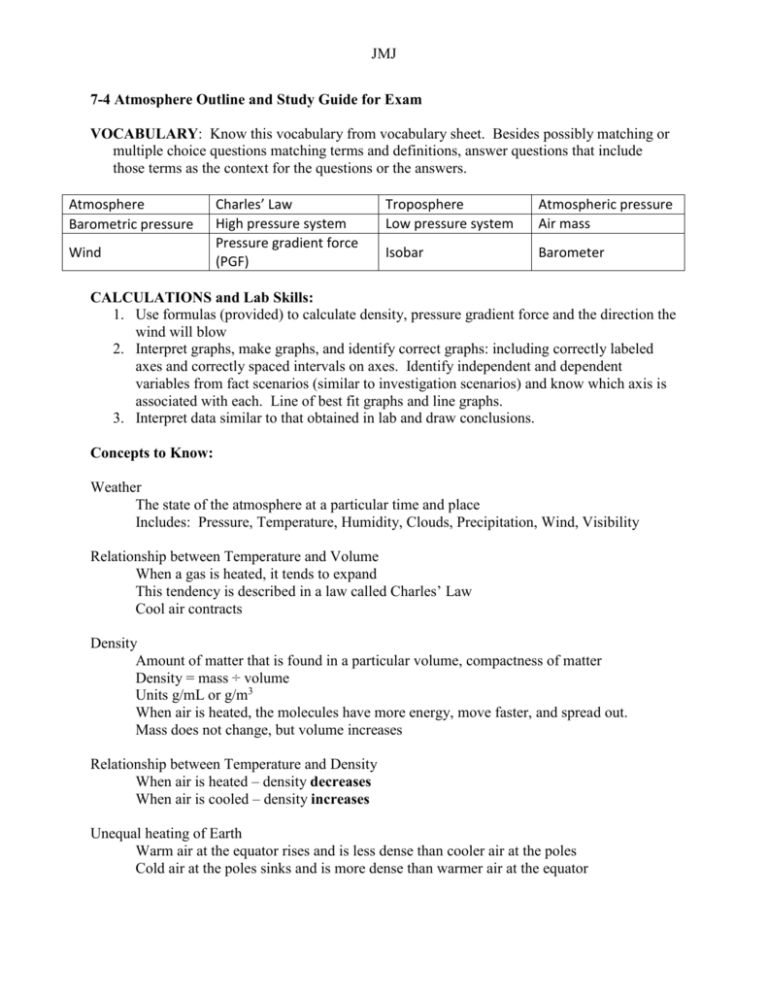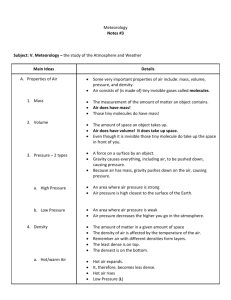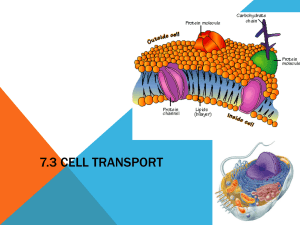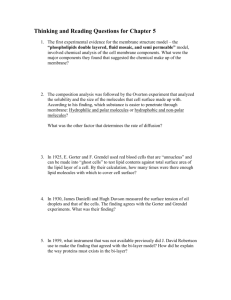JMJ 7-4 Atmosphere Outline and Study Guide for Exam
advertisement

JMJ 7-4 Atmosphere Outline and Study Guide for Exam VOCABULARY: Know this vocabulary from vocabulary sheet. Besides possibly matching or multiple choice questions matching terms and definitions, answer questions that include those terms as the context for the questions or the answers. Atmosphere Barometric pressure Wind Charles’ Law High pressure system Pressure gradient force (PGF) Troposphere Low pressure system Atmospheric pressure Air mass Isobar Barometer CALCULATIONS and Lab Skills: 1. Use formulas (provided) to calculate density, pressure gradient force and the direction the wind will blow 2. Interpret graphs, make graphs, and identify correct graphs: including correctly labeled axes and correctly spaced intervals on axes. Identify independent and dependent variables from fact scenarios (similar to investigation scenarios) and know which axis is associated with each. Line of best fit graphs and line graphs. 3. Interpret data similar to that obtained in lab and draw conclusions. Concepts to Know: Weather The state of the atmosphere at a particular time and place Includes: Pressure, Temperature, Humidity, Clouds, Precipitation, Wind, Visibility Relationship between Temperature and Volume When a gas is heated, it tends to expand This tendency is described in a law called Charles’ Law Cool air contracts Density Amount of matter that is found in a particular volume, compactness of matter Density = mass ÷ volume Units g/mL or g/m3 When air is heated, the molecules have more energy, move faster, and spread out. Mass does not change, but volume increases Relationship between Temperature and Density When air is heated – density decreases When air is cooled – density increases Unequal heating of Earth Warm air at the equator rises and is less dense than cooler air at the poles Cold air at the poles sinks and is more dense than warmer air at the equator Wind Air pressure and atmospheric motion – wind caused by differences in air pressure Wind: PGF: Pressure gradient force – winds blow from high pressure to low Air Pressure or Atmospheric Pressure Force exerted by molecules in atmosphere due to gravity and temperature Air pressure is the measure of the force with which air molecules push on a surface. Air Pressure is dependent on Density Denser air will have a higher air pressure - there are more air molecules in a given space to push down on you Less dense air will have a lower air pressure - there are fewer air molecules to push down on you. Impact of Water Content (humidity) on Air Pressure Moist air is less dense than dry air, and therefore has a lower air pressure. A water molecule has less mass than other molecules that make up the air. If you replace some of the air molecules with water molecules, the water lowers the density (and lowers the air pressure) Impact of Temperature on Air Pressure Warm air is less dense than cold air. Therefore, warm air has a lower air pressure and cold air has a higher air pressure. The molecules in warm air are moving fast and are spread farther apart. Therefore there are fewer air molecules in a given area to push down on you. Barometer The piece of equipment used to measure air pressure is a Barometer Air Pressure is measured in millibars (mb) on a barometer. Air Pressure Affects the Weather Air pressure in a weather system reflects the amount of water in the air, which affects the weather. High pressure area has less moisture and usually has clear, dry weather Low pressure area has more moisture and can have cloudy, rainy weather Air Pressure on a Weather Map Areas of High and Low pressure are shown on a weather map with an H or an L. Lines called isobars show areas of equal atmospheric pressure 2 low pressure high pressure warm or cold air warm cold air rising or sinking rising sinking clouds or no clouds clouds no clouds, clear weather molecules move fast or slow fast slow molecules are packed together or far apart far apart, less dense packed together, dense moist or dry moist dry Unit Summary The volume and density of air change with changes in temperature. As the temperature of air increases, its volume increases and its density decreases. As the temperature of air decreases, its volume decreases and its density increases. As air is heated, its density decreases because its mass remains constant but its volume increases. As air is cooled, its density increases because its mass remains constant but its volume decreases. Air is a fluid. Fluids that are denser sink below those that are less dense. The decrease in density as air is heated causes it to rise above cooler, denser air. The increase in density as air is cooled causes it to sink below warmer, less dense air. The warmer air in the atmosphere rises and cooler air in the atmosphere sinks. This causes convection currents in the atmosphere (moving air). Air that moves from the upper levels of the atmosphere downward towards Earth creates an area of high pressure beneath the falling air. Air that rises or moves upward from the Earth or from lower levels of the atmosphere toward the upper atmosphere creates an area of low pressure beneath the rising air. Cold air sinking would increase the pressure in an area while warm air rising would decrease the pressure in an area. When there are pressure differences in the atmosphere, are moves from areas of high pressure to areas of low pressure. This movement of air creates wind. 3 7-5 Cellular Organization Study Guide for Exam 1. Know all vocabulary from vocabulary sheet Cell membrane Nucleus Cell well Organelle Chloroplast Osmosis Cytoplasm Diffusion MICROSCOPE PARTS: Be able to match the part with its function 1. diaphragm 2. stage 3. eyepieces or oculars 4. arm 5. revolving nosepiece 6. stage clip 7. objectives 8. knobs to control slide movement 9. coarse focus knob 10. fine focus knob 11. light source 12. base CELL PARTS: Be able to name, give a function, and identify in a picture the following parts: Cell (plasma) membrane Nucleus nuclear (membrane) envelope nucleolus centrioles mitochondria rough endoplasmic reticulum smooth endoplasmic reticulum Golgi (body) apparatus Ribosomes Chloroplast cell wall vacuole cytoplasm lysosomes Also know: Movement of water through a cell membrane 4 COMPARISION: What is a prokaryote? A eukaryote? How are prokaryotes and eukaryotes different? How are plant, animal, and bacterial cells alike and different? What organelles are found only in plants? What organelles are found only in animals? What are the similarities and difference between osmosis, diffusion, and active and passive transport? Identify scenarios where diffusion, osmosis, active transport are taking place. Unit Summary Plant cells generally contain a nucleus, a cell wall, a cell membrane, chloroplasts, a large vacuole, and cytoplasm. However, under a magnification of 100X, it is not possible to differentiate between the cell wall and the cell membrane. In addition, not all plant cells contain chloroplasts. Animal cells generally contain a nucleus, cell membrane, and cytoplasm. Animal cells also contain organelles called centrioles which are very small and usually not visible unless the cell is dividing. Some animal cells, such as red blood cells, do not contain nuclei. The cell membrane of a plant cell is not permeable to salt. This was evidenced by the shrinking of the cells. To balance the concentration of salt within and outside the cell, water flowed from the cells into the surrounding environment. If the cell membrane was permeable to salt, water and salt could have both flowed back and forth through the cell membrane until both environments contained equal concentrations of salt. The cell membrane of an egg is not permeable to sugar. This was evidenced by the shrinking of the eggs. To balance the concentration of sugar inside and outside the egg, water flowed from the eggs into the surrounding environment (corn syrup). If the cell membrane was permeable to sugar, water and sugar could have both flowed back and forth through the cell membrane until both environments contained equal concentrations of sugar. The cell wall and cell membrane of a plant cell are permeable to water. This was evidenced by the shrinking of cells. To balance the concentration of salt inside and outside the cells, water flowed from the cells into the surrounding environment. If the cell membrane and cell wall were not permeable to water, the cells would not have shrunk. The cell membrane of the egg was also permeable to water. Water flowed from the egg into the corn syrup and from the water into the shrunken egg. The structure of the cell wall and cell membrane determines whether or not each structure is permeable to salt and water. The permeability of each structure determines whether or not salt moves in or out, which in turn affects whether or not water moves in and out of the cell. 5 7-7 DNA Study Guide for Exam 1. Know all vocabulary from vocabulary sheet DNA Gene Chromosome Replication Nucleotide Nitrogenous Bases 1. Identify three parts of a nucleotide – name them, identify them in a diagram 2. Describe the ways phosphate and sugar molecules form the “side sections” of a DNA molecule 3. Name nitrogenous base pairs found in DNA 4. Identify the bases that pair together 5. Identify correctly paired sections of DNA, complete sections of DNA that are incomplete 6. Explain the advantages of hydrogen bonds connecting base pairs in DNA 7. Put the steps of DNA replication in the correct order 8. Identify the location of DNA replication 6








